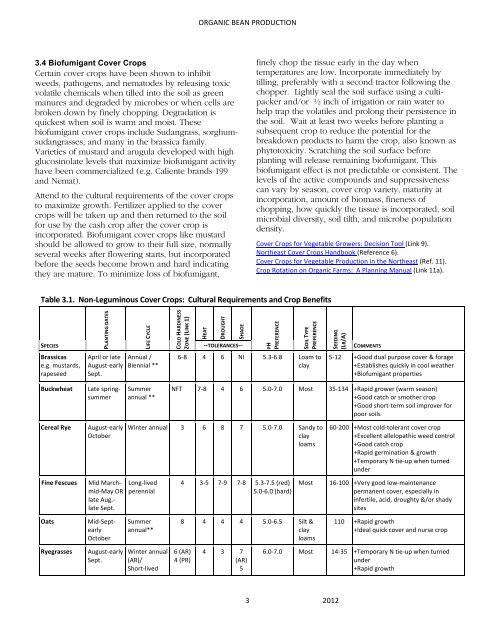beans 4-24-12 CLEAN - Vegetableipmasia.org
beans 4-24-12 CLEAN - Vegetableipmasia.org
beans 4-24-12 CLEAN - Vegetableipmasia.org
You also want an ePaper? Increase the reach of your titles
YUMPU automatically turns print PDFs into web optimized ePapers that Google loves.
ORGANIC BEAN PRODUCTION <br />
3.4 Biofumigant Cover Crops<br />
Certain cover crops have been shown to inhibit<br />
weeds, pathogens, and nematodes by releasing toxic<br />
volatile chemicals when tilled into the soil as green<br />
manures and degraded by microbes or when cells are<br />
broken down by finely chopping. Degradation is<br />
quickest when soil is warm and moist. These<br />
biofumigant cover crops include Sudangrass, s<strong>org</strong>humsudangrasses,<br />
and many in the brassica family.<br />
Varieties of mustard and arugula developed with high<br />
glucosinolate levels that maximize biofumigant activity<br />
have been commercialized (e.g. Caliente brands 199<br />
and Nemat).<br />
Attend to the cultural requirements of the cover crops<br />
to maximize growth. Fertilizer applied to the cover<br />
crops will be taken up and then returned to the soil<br />
for use by the cash crop after the cover crop is<br />
incorporated. Biofumigant cover crops like mustard<br />
should be allowed to grow to their full size, normally<br />
several weeks after flowering starts, but incorporated<br />
before the seeds become brown and hard indicating<br />
they are mature. To minimize loss of biofumigant,<br />
finely chop the tissue early in the day when<br />
temperatures are low. Incorporate immediately by<br />
tilling, preferably with a second tractor following the<br />
chopper. Lightly seal the soil surface using a cultipacker<br />
and/or ½ inch of irrigation or rain water to<br />
help trap the volatiles and prolong their persistence in<br />
the soil. Wait at least two weeks before planting a<br />
subsequent crop to reduce the potential for the<br />
breakdown products to harm the crop, also known as<br />
phytotoxicity. Scratching the soil surface before<br />
planting will release remaining biofumigant. This<br />
biofumigant effect is not predictable or consistent. The<br />
levels of the active compounds and suppressiveness<br />
can vary by season, cover crop variety, maturity at<br />
incorporation, amount of biomass, fineness of<br />
chopping, how quickly the tissue is incorporated, soil<br />
microbial diversity, soil tilth, and microbe population<br />
density.<br />
Cover Crops for Vegetable Growers: Decision Tool (Link 9). <br />
Northeast Cover Crops Handbook (Reference 6). <br />
Cover Crops for Vegetable Production in the Northeast (Ref. 11). <br />
Crop Rotation on Organic Farms: A Planning Manual (Link 11a).<br />
Table 3.1. Non-‐Leguminous Cover Crops: Cultural Requirements and Crop Benefits <br />
SPECIES <br />
PLANTING DATES <br />
LIFE CYCLE <br />
COLD HARDINESS <br />
ZONE (LINK 1) <br />
HEAT <br />
DROUGHT <br />
SHADE <br />
-‐-‐TOLERANCES-‐-‐ <br />
PH <br />
PREFERENCE <br />
SOIL TYPE <br />
PREFERENCE <br />
SEEDING <br />
(LB/A) <br />
COMMENTS <br />
Brassicas <br />
e.g. mustards, <br />
rapeseed <br />
April or late Annual / <br />
August-‐early Biennial ** <br />
Sept. <br />
6-‐8 4 6 NI 5.3-‐6.8 Loam to <br />
clay <br />
5-‐<strong>12</strong> <br />
+Good dual purpose cover & forage <br />
+Establishes quickly in cool weather <br />
+Biofumigant properties <br />
Buckwheat <br />
Late spring-summer<br />
<br />
Summer <br />
annual ** <br />
NFT 7-‐8 4 6 5.0-‐7.0 Most 35-‐134 +Rapid grower (warm season) <br />
+Good catch or smother crop <br />
+Good short-‐term soil improver for <br />
poor soils <br />
Cereal Rye <br />
Fine Fescues <br />
August-‐early <br />
October <br />
Mid March-‐ Long-‐lived <br />
mid-‐May OR perennial <br />
late Aug.-‐ <br />
late Sept. <br />
Winter annual 3 6 8 7 5.0-‐7.0 Sandy to <br />
clay <br />
loams <br />
4 3-‐5 7-‐9 7-‐8 5.3-‐7.5 (red) <br />
5.0-‐6.0 (hard) <br />
Most <br />
60-‐200 +Most cold-‐tolerant cover crop <br />
+Excellent allelopathic weed control <br />
+Good catch crop <br />
+Rapid germination & growth <br />
+Temporary N tie-‐up when turned <br />
under <br />
16-‐100 +Very good low-‐maintenance <br />
permanent cover, especially in <br />
infertile, acid, droughty &/or shady <br />
sites <br />
Oats <br />
Ryegrasses <br />
Mid-‐Sept-‐ <br />
early <br />
October <br />
August-‐early <br />
Sept. <br />
Summer <br />
annual** <br />
Winter annual <br />
(AR)/ <br />
Short-‐lived <br />
8 4 4 4 5.0-‐6.5 Silt & <br />
clay <br />
loams <br />
6 (AR) <br />
4 (PR) <br />
4 3 7 <br />
(AR) <br />
5 <br />
110 +Rapid growth <br />
+Ideal quick cover and nurse crop <br />
6.0-‐7.0 Most 14-‐35 +Temporary N tie-‐up when turned <br />
under <br />
+Rapid growth <br />
3 <br />
20<strong>12</strong>




![Section 4 [ PDF file, 252 KB] - The Field Alliance](https://img.yumpu.com/51387260/1/158x260/section-4-pdf-file-252-kb-the-field-alliance.jpg?quality=85)












